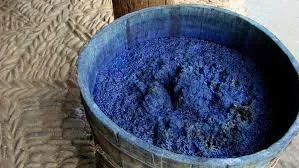Exploring the Benefits and Applications of Indigo Synthetic Products in Modern Industries
The Evolution and Impact of Indigo Synthetic Products
Indigo, a deep blue dye that has been used for centuries, has intrigued cultures around the world. Traditionally derived from the indigo plant, the dye has been integral to textiles and art, giving vibrant color to garments and crafts. However, with the demands of modern manufacturing and sustainability, the emergence of synthetic indigo products has significantly altered the landscape of dyeing techniques and industries.
Synthetic indigo, chemically known as indigo blue, was first synthesized in the late 19th century by Adolf von Baeyer, which revolutionized the textile industry. This development came at a crucial time when the demand for indigo was escalating, driven by the booming fashion industry. Natural indigo extraction was labor-intensive and costly, leading to challenges in meeting market demands. Synthetic indigo provided a solution; it could be produced in large quantities at a lower cost, thus making it accessible to a broader audience.
The Evolution and Impact of Indigo Synthetic Products
However, the rise of synthetic indigo products has not been without controversy. Environmental concerns surrounding the production of synthetic dyes have come to the forefront. The synthesis process often involves toxic chemicals and typically releases harmful byproducts into water systems. Such environmental degradation poses significant risks to ecosystems, leading to scrutiny from environmental groups and consumers alike. This has prompted many players in the textile industry to seek more sustainable alternatives, including bio-based dyes and improved production methods that minimize environmental impact.
indigo synthetic product

Furthermore, the cultural significance of traditional indigo is often lost with the shift toward synthetic products. For many communities, the cultivation and dyeing using natural indigo is an art form intertwined with heritage and tradition. The shift to synthetic alternatives has raised questions about authenticity in craftsmanship and cultural identity. Balancing modernity with tradition remains a complex challenge facing the textile industry.
In response to these challenges, innovations in dye science are evolving. Researchers are exploring ways to produce synthetic indigo with reduced environmental impacts, such as utilizing green chemistry principles and optimizing processes to minimize waste and energy consumption. Additionally, there is a growing trend toward circular fashion, where dyes and materials are recycled, and the lifecycle of a product is extended, reducing the overall demand for new materials.
The growing consumer awareness of sustainability is influencing market dynamics, pushing brands to be more transparent about their sourcing and production methods. Companies that focus on eco-friendly practices, including the use of organic raw materials and non-toxic dyes, are becoming increasingly popular among conscious consumers. Brands that pay homage to traditional methods while integrating synthetic products are finding a unique niche in today's marketplace.
In conclusion, the journey of indigo from natural to synthetic products embodies the intersection of tradition and innovation. As the demands of modern consumerism clash with the principles of sustainability and cultural preservation, the future of indigo products will likely continue to evolve. Balancing the benefits of synthetic indigo with efforts to reduce environmental impact while respecting the heritage of its natural counterparts will define the next chapter in the storied history of this beloved dye.
-
Thermal Stability Analysis of Bromo Indigo Pigments
NewsJun.06,2025
-
Sulphur Black Dye Oxidation Process Optimization
NewsJun.06,2025
-
Lightfastness Testing of Bromo Indigo Dyed Denim
NewsJun.06,2025
-
Granule Size Distribution and Jeans Color Uniformity
NewsJun.06,2025
-
Gradient Dyeing Methods with Indigo Blue Granules
NewsJun.06,2025
-
Dyeing Temperature Effects on Sulphur Black Color Fastness
NewsJun.06,2025
-
Sulphur Black Dyes in Daily Use
NewsMay.07,2025

Sulphur Black
1.Name: sulphur black; Sulfur Black; Sulphur Black 1;
2.Structure formula:
3.Molecule formula: C6H4N2O5
4.CAS No.: 1326-82-5
5.HS code: 32041911
6.Product specification:Appearance:black phosphorus flakes; black liquid

Bromo Indigo; Vat Bromo-Indigo; C.I.Vat Blue 5
1.Name: Bromo indigo; Vat bromo-indigo; C.I.Vat blue 5;
2.Structure formula:
3.Molecule formula: C16H6Br4N2O2
4.CAS No.: 2475-31-2
5.HS code: 3204151000 6.Major usage and instruction: Be mainly used to dye cotton fabrics.

Indigo Blue Vat Blue
1.Name: indigo blue,vat blue 1,
2.Structure formula:
3.Molecule formula: C16H10N2O2
4.. CAS No.: 482-89-3
5.Molecule weight: 262.62
6.HS code: 3204151000
7.Major usage and instruction: Be mainly used to dye cotton fabrics.

